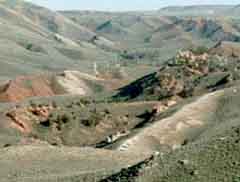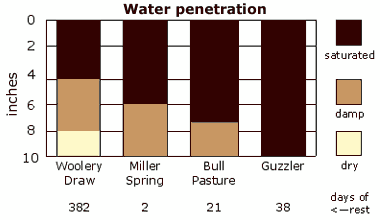by Tony Malmberg
Lander, Wyoming, U.S.A.
Summary: Pasture grazed and then allowed to rest 5 weeks showed better water infiltration than pasture rested either for shorter periods or for a year.
These are the results of a test I did in 21 June of 1997. A flash rain went through an area where I had four pastures of similar topography and soil. We got 2" (50 mm) of rain in 30 minutes.

Two inches is significant in our 13" (330 mm) precipitation area, where most moisture falls in early spring and early autumn. If we don't have a good water cycle to hold the moisture in the root zone until the growing season, we are in trouble.
I had been told that 1" of rain will saturate 7" of soil. Three days after the rain, I dug down to see how much went in the ground. As you can tell by now, this was not a scientific, peer reviewed study, just a curious cowboy study.
I selected my dig sites with the idea that I wanted the water to be on the move as soon as it contacted the earth, so it wouldn't simply sit until it eventually soaked in. I also wanted sites uninfluenced by water running onto them from somewhere else. The sites I picked met these criteria:
- Gentle slope just off a ridge top.
- Sandy and rocky soil consisting of rocks mostly 0.5 inch up to 3" (13-75 mm).
- Bare ground site surrounded by plants.
- Immediately behind a litter dam or potential litter dam site.
Litter dams are plant material on the soil that can catch water and slow its flow across slopes. Well-managed livestock trample lots of litter onto the ground, which protects the soil surface.
1200 cow-calf pairs grazed Woolery Draw for 7 days on the last week of June in 1996. 960 yearling steers grazed the other pastures for periods ranging from 6 to 19 days.
 |
As you see, the pasture rested for over a year showed the shallowest water infiltration -- just 4 inches (100mm) saturation, with 2 more inches (50 mm) damp. The pasture grazed two days before the rain showed saturation to 6" (150 mm), the pasture rested 21 days got saturated to 7.5" (190 mm), and the pasture rested 38 days after grazing got saturated to a full 10" (250 mm).
These results show that animal impact and grazing are clearly important to the water cycle. But rest and recovery also improve water cycle effectiveness.
-- Tony Malmberg
© 2003
Posted 23 March 2003